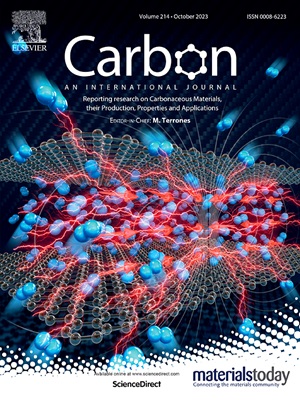NIR-II发射具有多酶模拟活性的氟掺杂碳点,用于NIR-II成像和光热增强癌症催化免疫治疗
IF 11.6
2区 材料科学
Q1 CHEMISTRY, PHYSICAL
引用次数: 0
摘要
催化免疫治疗是缓解肿瘤转移和复发的一种很有前途的方法。各种先进的催化材料的探索为加强这种治疗开辟了新的途径。然而,同时具有NIR- ii发射和NIR光活性的无金属碳点纳米酶目前很少。在这里,我们报道了一种无金属的多功能纳米酶,f掺杂CDs (F-CDs)纳米酶,它具有高NIR-II量子产率和NIR-I光热效应,可用于癌症催化免疫治疗。F-CDs纳米酶具有模拟三酶的催化活性,包括过氧化物酶(POD)、谷胱甘肽过氧化物酶(GSH-px)和葡萄糖氧化酶(Gox)。用PEG修饰后,F-CDs@PEG在体内表现出优异的NIR-II生物成像,与fda批准的染料吲哚菁绿(ICG)相当。在近红外激光照射下,F-CDs@PEG的催化活性显著增强,破坏肿瘤细胞的能量代谢和氧化还原平衡,引发强烈的肿瘤免疫治疗,重塑肿瘤免疫微环境(TIME)。有趣的是,我们发现F-CDs@PEG可以抑制免疫抑制性骨髓源性抑制细胞(MDSCs)并缓解t细胞衰竭,从而增强肿瘤生长抑制和减少脾肿大。重要的是,F-CDs@PEG-mediated光热增强的催化免疫疗法可以诱导强大的免疫记忆,为肿瘤复发提供长期保护。总的来说,这项研究的成功为未来设计和探索NIR-II cd纳米酶和用于催化免疫治疗的无金属纳米催化剂提供了可行的策略。本文章由计算机程序翻译,如有差异,请以英文原文为准。

NIR-II emitting fluorine-doped carbon dots with multi-enzyme mimic activities for NIR-II imaging and photothermal-enhanced cancer catalytic immunotherapy
Catalytic immunotherapy represents a promising approach to mitigate tumor metastasis and recurrence. The exploration of various advanced catalytic materials is opening new avenues for enhancing this therapy. However, metal-free carbon dot nanozymes with both NIR-II emission and NIR photoactivity are currently rare. Here, we report a metal-free multifunctional nanozyme, F-doped CDs (F-CDs) nanozyme, which exhibits a high NIR-II quantum yield and NIR-I photothermal effect for cancer catalytic immunotherapy. The F-CDs nanozyme demonstrated triplezyme-mimicking catalytic activity, including peroxidase (POD), glutathione peroxidase (GSH-px), and glucose oxidase (Gox). After modification with PEG, F-CDs@PEG exhibited excellent NIR-II bioimaging in vivo, comparable to FDA-approved dye indocyanine green (ICG). Under NIR laser irradiation, the remarkably enhanced catalytic activity of F-CDs@PEG disrupts the energy metabolism and redox balance of tumor cells, triggering intense tumor immunotherapy and reshaping the tumor immune microenvironment (TIME). Interestingly, we found that F-CDs@PEG can suppress immunosuppressive myeloid-derived suppressor cells (MDSCs) and alleviate T-cell exhaustion, leading to enhanced tumor growth inhibition and reduced splenomegaly. Importantly, F-CDs@PEG-mediated photothermal-enhanced catalytic immunotherapy can induce robust immune memory, offering long-term protection against tumor recurrence. Overall, the success of this study offers a feasible strategy for the future design and exploration of NIR-II CD-based nanozymes and metal-free nanocatalysts for catalytic immunotherapy.
求助全文
通过发布文献求助,成功后即可免费获取论文全文。
去求助
来源期刊

Carbon
工程技术-材料科学:综合
CiteScore
20.80
自引率
7.30%
发文量
0
审稿时长
23 days
期刊介绍:
The journal Carbon is an international multidisciplinary forum for communicating scientific advances in the field of carbon materials. It reports new findings related to the formation, structure, properties, behaviors, and technological applications of carbons. Carbons are a broad class of ordered or disordered solid phases composed primarily of elemental carbon, including but not limited to carbon black, carbon fibers and filaments, carbon nanotubes, diamond and diamond-like carbon, fullerenes, glassy carbon, graphite, graphene, graphene-oxide, porous carbons, pyrolytic carbon, and other sp2 and non-sp2 hybridized carbon systems. Carbon is the companion title to the open access journal Carbon Trends. Relevant application areas for carbon materials include biology and medicine, catalysis, electronic, optoelectronic, spintronic, high-frequency, and photonic devices, energy storage and conversion systems, environmental applications and water treatment, smart materials and systems, and structural and thermal applications.
 求助内容:
求助内容: 应助结果提醒方式:
应助结果提醒方式:


